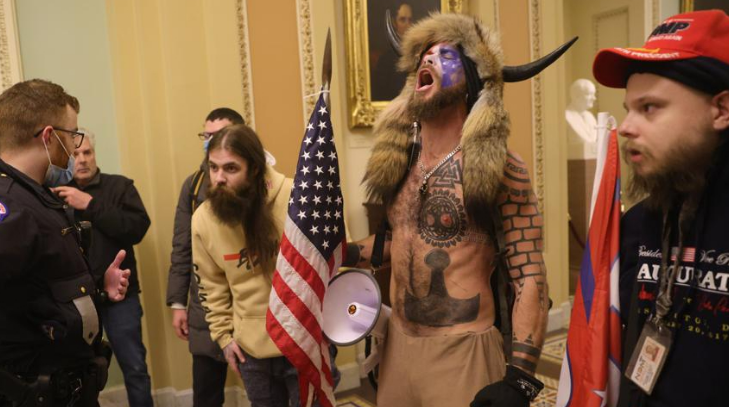
- Details
- By Levi Rickert & Kyle Edwards
WASHINGTON — Meet Jake Angeli, the Trump supporter who stormed the U.S. Capitol on Wednesday with his face painted, bare-bodied and wearing a fur headdress with black buffalo horns.
Angeli is a 33-year-old QAnon supporter, who was spotted last year at various right-wing political rallies in Arizona. Last February, he protested outside the Arizona State Capitol during a pro-Trump rally with a sign that read, “Q Sent Me.”
Arizona Republic reported Angeli was shouting, “You all know who Q is?” and explained to passersby that Q “was a government agent who wanted to ‘take the country back’ from pedophiles and globalists.”
In his other life, he wants to be an actor, does voice over, and touts his public speaking skills.
After appearing in numerous photographs taken at the Capitol on Wednesday, a number of people on Native social media pages speculated whether Angeli might be Indigenous. Many wanted to know who he was and where he was from, and some were relieved to know he is not Native, despite his fur-clad outfit.
 Memes were quickly shared on social media after Jake Angeli appeared in a number of photos depicting rioters at the U.S. Capitol.
Memes were quickly shared on social media after Jake Angeli appeared in a number of photos depicting rioters at the U.S. Capitol.
Some found Angeli’s costume, not to be confused with regalia, humorous. Photos of Angeli produced humorous memes on social media, similar to Election Day night last November when CNN referred to Native Americans as “something else” in an exit-poll segment.
Well, Angeli is not Native American, but it can be said he is “something else.”
Angeli, who clearly trespassed when he entered the Senate chamber, made his way to the speaker’s desk.
Amid the chaos on Wednesday, Angeli told a Globe and Mail reporter that police eventually gave up trying to stop him and other Trump supporters who breached the Capitol. After some time passed, police “politely” asked Angeli to leave and let him go free.
Help us tell the stories that could save Native languages and food traditions
At a critical moment for Indian Country, Native News Online is embarking on our most ambitious reporting project yet: "Cultivating Culture," a three-year investigation into two forces shaping Native community survival—food sovereignty and language revitalization.
The devastating impact of COVID-19 accelerated the loss of Native elders and with them, irreplaceable cultural knowledge. Yet across tribal communities, innovative leaders are fighting back, reclaiming traditional food systems and breathing new life into Native languages. These aren't just cultural preservation efforts—they're powerful pathways to community health, healing, and resilience.
Our dedicated reporting team will spend three years documenting these stories through on-the-ground reporting in 18 tribal communities, producing over 200 in-depth stories, 18 podcast episodes, and multimedia content that amplifies Indigenous voices. We'll show policymakers, funders, and allies how cultural restoration directly impacts physical and mental wellness while celebrating successful models of sovereignty and self-determination.
This isn't corporate media parachuting into Indian Country for a quick story. This is sustained, relationship-based journalism by Native reporters who understand these communities. It's "Warrior Journalism"—fearless reporting that serves the 5.5 million readers who depend on us for news that mainstream media often ignores.
We need your help right now. While we've secured partial funding, we're still $450,000 short of our three-year budget. Our immediate goal is $25,000 this month to keep this critical work moving forward—funding reporter salaries, travel to remote communities, photography, and the deep reporting these stories deserve.
Every dollar directly supports Indigenous journalists telling Indigenous stories. Whether it's $5 or $50, your contribution ensures these vital narratives of resilience, innovation, and hope don't disappear into silence.
 The stakes couldn't be higher. Native languages are being lost at an alarming rate. Food insecurity plagues many tribal communities. But solutions are emerging, and these stories need to be told.
The stakes couldn't be higher. Native languages are being lost at an alarming rate. Food insecurity plagues many tribal communities. But solutions are emerging, and these stories need to be told.
Support independent Native journalism. Fund the stories that matter.
Levi Rickert (Potawatomi), Editor & Publisher
